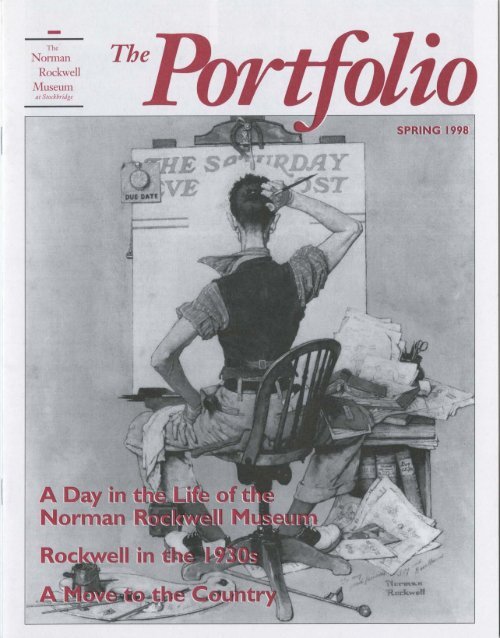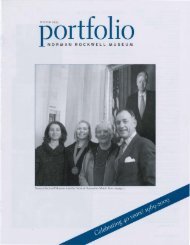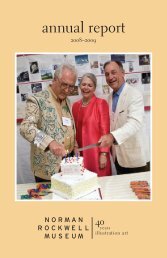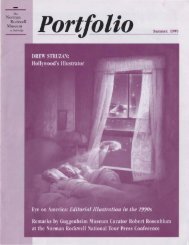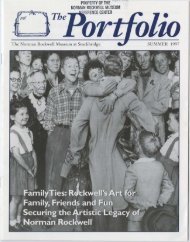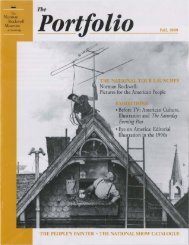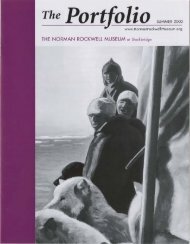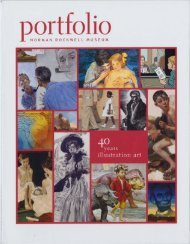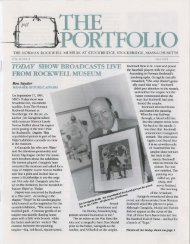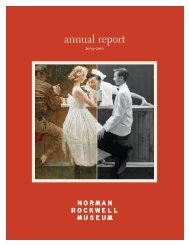Spring 1998 - Norman Rockwell Museum
Spring 1998 - Norman Rockwell Museum
Spring 1998 - Norman Rockwell Museum
You also want an ePaper? Increase the reach of your titles
YUMPU automatically turns print PDFs into web optimized ePapers that Google loves.
-T he<strong>Norman</strong><strong>Rockwell</strong><strong>Museum</strong>at Stockb1"idgeTheetoSP. I G <strong>1998</strong>
!l!T"~)\-'7, ~T"~~iIfr~ ... tIf:I:I. tJ7?"-sJ~ 1iHighlights from the CollectioD of The <strong>Norman</strong> Rock. ell Mu,eum~Above, Home for Christmas, a 1955 Schaeffer pen-penciladvertisement is one of the paintings that promoted theexhibition with posters on billboards and subways. Aboveright, among the guests at the Isetan <strong>Museum</strong> enjoyingthe original <strong>Rockwell</strong> paintings, are two young ladieswho seem to be studying the American rite of marriageas depicted in the 1955 Saturday Evening Post cover,The Marriage License.<strong>Rockwell</strong> in JapanDECEMBER 4, 1997, HIGHLIGHTS FROM THE COLLECTIONof the <strong>Norman</strong> <strong>Rockwell</strong> <strong>Museum</strong> opened in Tokyo. Hereare photographs from the opening at the Isetan <strong>Museum</strong>,and one of the posters used to advertise the exhibition.After Tokyo, the exhibit traveled to Nagoya, Chiba,Niigata, Osaka and Hiroshima.Right, Linda Szekely,NRM AssistantCurator; TomomiTanikawa of BrainTrust, Inc.; JosephineNieuwenhuis, NRMProject Registrar; andYuko Toyota, also ofBrain Trust, Inc.,enjoy the successfulopening. Linda andJosephine courieredthe artwork to Japanwhere they weregraciously assisted byMs. Tanikawa andMs. Toyota.Below, <strong>Norman</strong> <strong>Rockwell</strong> <strong>Museum</strong> BoardPresident, David Klausmeyer and DirectorLaurie Norton Moffatt attend the openingreception with Takeshi Matsumoto,Director of the Chihiro Iwasaki <strong>Museum</strong> ofPicture Books; Josephine Nieuwenhuis,NRM Project Registrar; Linda Szekely,NRM Assistant Curator; and MasahikoShibata, President of Brain Trust, Inc., thesponsor of the exhibition.<strong>Museum</strong> DirectorLaurie NortonMoffatt is seen hereat the opening withPeter J. Kovach,Counselor forCultural Affairs atthe Embassy of theUnited States.
4IWOULD LIKE TO TAKE YOUthrough a day in the life ofthe <strong>Norman</strong> <strong>Rockwell</strong><strong>Museum</strong> to show you some ofwhat occurs behind the scenebefore we open the doors towelcome you, to the time weturn out the lights. Come withme now as we start the day.It is early in the morning, andmembers of our facility staffarrive. A team of four, headed byBill Boyer, takes care of ourbuildings, grounds, and security.Each day brings new adventures.At this quiet hour, the crewexpect to find deer munching onour shrubs and wild turkeysscratching about, but today theunexpected has happened.Snapping turtles are determinedlymoving over thegrounds! They are beingrounded up in the tractor bucketand returned to the HousatonicRiver that surrounds our museumgrounds.Inside the museum, preopeningactivities are underway.The cleaning crew is polishingthe final touches before theyleave by 10:00 o'clock. WeA Day in the Life of the<strong>Norman</strong> <strong>Rockwell</strong> <strong>Museum</strong>Laurie Norton Moffatt, DirectorDay in the Life of a Little Girl, oil on canvas,Saturday Evening Post, August 30, 1952, cover.won't have time to meetall of our staff, so let'speek in on a few whorarely are seen by thepublic.Let's start in thecuratorial department,-g under the direction of~~ curator Maureen Hart~ Hennessey. The curators~ are responsible for every[ step of exhibition~ planning, from choicer and installation of the~ exhibit, to all the related~ written materialso~ identification labels,~ posters, and brochures.~ Once an exhibition~ opening date has been'--_____________________ ---' J publicized, it is inflex-In 1952, <strong>Norman</strong> <strong>Rockwell</strong> painted two Saturday EveningPost covers showing the life of a little boy and the life of a littlegirl from their wake-up moments until their bedtime. Eachpainting depicted over twenty scenes from their day.ible, and the entireexhibit team is totally focusedon opening day. If you peer in aground floor office and see .someone working at her computerscreen, with phone to herear and pencil in hand, you mayhave just glimpsed our curatorMaureen.Gary Eveland, our preparator,is in charge of the physicalinstallation of an exhibition.Gary's area is where framing isdone, rental slides and photosare filed, and art that is notcurrently on exhibit in ourgalleries is stored. YesterdayGary returned from transportingartwork from New YorkCity for a new exhibit, and todayhe will start framing some of the100 pieces. When he finishes, hewill design the lighting andbegin hanging the works withthe curators and facility crew.Gary also takes care of our artcollection. If you catch sight ofsomeone with a hammer andmeasuring tape, and a lightfixture under his arm, you'veundoubtedly met ourpreparator.While we are still on themuseum's lower level, I'll takeyou into the archives andreference center. The assistantcurator, Linda Szekely, is incharge of this section. Thearchives area is the repositoryfor all of <strong>Norman</strong> <strong>Rockwell</strong>'spersonal papers, photographs,negatives, magazine tear sheets,and items far too numerous tomention. Volunteers MargeryHall and Robert Kuhner assistLinda with many donated hoursin cataloguing the archives,along with Cris Raymond whoalso is editor of The Portfolio.The reference center is themuseum library, open to thepublic three afternoons a week.Authors, researchers, grandchildrenin search of a painting thatthey "know" grandpa once
5Framed, SaturdayEvening Post,March 2, 1946,cover,whereaboutsunknown.posed for, and anyone whothinks he has an original<strong>Rockwell</strong> painting might becalling Linda today. Every itemin <strong>Norman</strong> <strong>Rockwell</strong>'s studio isunder the care of this department;in addition, museumarchival exhibits, which are verypopular with the public, areorganized from here. If youshould happen to meet someonewith a magnifying glass in onehand examining a vintagephotograph while referencingthe Definitive Catalogue, youprobably have just seen Linda.We'll go out the library door,but please be careful not tobump into the rolling carts inthe hallway. The warehouse,staffed by Allen Bell and EdMcHugh, is a busy center thatreplenishes the stocks in thestore, receives shipments,circulates the inter-office mailand processes the many printrequests received through thepost and via e-mail. Right nowthey are loading new items totake upstairs to the museumstore and stacking packages totake to the post office. Theyhave to be out of the way beforeopening time, as visitors havebeen known to want to buyitems right off the carts!Before we proceed up the stairs,have a quick look into theclassrooms. On weekends andholidays, these rooms are themost exciting place to be. Createa drawing, make a puppet, buildwith clay, fold paper animals,and above all learn and have funwith Melinda Georgeson,manager of youth services. Ifyou see an artist going down thehall carrying pots of paint wholooks like she is having the besttime, it's Melinda.Maud Ayson, associatedirector for education andprogram, oversees the museum'spublic and education programs,and, with her staff, plans theseminars attended by teachersfrom all over the country. Also,Maud is in charge of the teamthat meets daily with our public.She scoots between her downstairsoffice and the upstairsgalleries checking to makecertain that everything is runningsmoothly. If you think youhave seen Maud, you are probablymistaken, unless you aremoving very quickly!We are upstairs at the museumnow and still have time topop into the museum storebefore it opens. Jo AnnLosinger, director of marketing,is examining some new itemsselected to appeal to our visitors,and is looking over the collectionof signed prints that<strong>Norman</strong> <strong>Rockwell</strong> left for us toraise funds for art acquisition.The store windows have justbeen artfully decorated for theseason. The entire area is sobeautifully arranged that it is nowonder that this is one of themost popular areas of themuseum for visitors who want totake a memory home. You willfind <strong>Rockwell</strong> prints, books, Tshirts, children's art supplies,and even NR's favorite oatmealcookies.Sara Andenmatten, Josie Ellisand the store staff advise andcare for our visitors. But, pleasedo not peek behind the counterbecause you just might find arow of shoes on the bottomshelf! At the end of a hectic day,our sales staff still have smilingfaces but often very tired toes asthey close up for the day.We have to hurry because I hearthe buses coming into theparking lot. We expect 20 bustours to arrive today, in additionto our individual guests. Ourvisitor services assistants, frontdesk personnel and guides maybe greeting over 1,500 peopletoday. Bus tours are arrangedand coordinated with JosephAubert, Jane Salvatore, AbigailDiamant and Kim Conley, butoccasionally an unexpected tourarrives and everyone has to beon the alert. At such times, extragallery tours are added to theregular hourly ones, and to keepthe flow of visitors movingsmoothly, some groups areasked to visit the studio first.Flexibility is the rule of the day.The grandfather clock in thehall is ringing ten o'clock andthe museum is ready to open.Let's slip out the terrace doorand stroll over the beautifulgrounds to Linwood House,where the administration officesare located.
6On the ground floor ofLinwood we find Jean Drees, ourpersonnel manager, who notonly takes care of our museumstaff, but also writes the in-housenewsletter The Gossips, whichkeeps us informed on thecomings and goings of the staff.Jean is an exampleof the spirit of theentire museumfamily in that herduties go beyondthe human resourcearea tolending a hand tomany other depart- ai~ments. ~Phil Deely,associate director ~of external relations,wears manyhats. Today, inaddition to polishinga grant that he §uis writing, he hasan appointment todiscuss plannedgiving with aprospective donorand is finalizing theannual fun andfund raising event.His assistant Suzy Sheridan isoverseeing menu, seating arrangements,and invitations for abenefit dinner. Everyone withextra time will be helping out.Martin Terrien, associatedirector for finance and administration,keeps the black inkflowing as he oversees thebudget, while Sherida Lincoln,our bookkeeper, monitorsmyriad and minute accountingdetails. Priscilla Ethredge, whotakes care of our museummembers, drops off her membershipreceipts to Sherida fordeposit in the bank.I now want to introduce youto Bea Snyder, manager ofpublic affairs and membership. for a few trustees. Awaiting myAhh, she's not there-well, she is follow-up are e-mail messages,probably at a Berkshire Visitors faxes, phone calls and today'sBureau meeting, or maybe she is post. A quick review of thein Boston today with the MassachusettsOffice of Travel and upcoming board, staff andcalendar shows a variety ofTourism. Perhaps her assistant community meetings, withSally Underwood-Miller has a travel plans in the works for theinternationalexhibit in Japan.Oh yes, did Imention the paperdue tomorrow formy MBA class?And so, althoughthe scene outsidemy window beckonsfor a briskstroll along the LilaBerle River Walk,perhaps I shouldleave you and getback to work.Please stay andvisit the galleries,<strong>Norman</strong> <strong>Rockwell</strong>'sstudio, and watchthe video N.R.narrated. We closeat five o'clock, atTired Sales Girl on Christmas Eve, oil on canvas, least for the dailySaturday Evening Post, December 27, 1947, cover. activities. But domoment, if she is not on thephone with ABC or touring thegrounds with two internationalreporters.The third floor is home toour telephone receptionistLaura Tota and customerservice staff, Mary Dawson,Ellen Mazzer, and StephanieLeach. A beehive of activitycontinues apace here in thiscenter of telephone communicationwith our world-wideaudience.Dash back down the stairs withme to the second floor. I'mdelighted to invite you into myoffice, where my secretary AnnSterlin is setting up a light lunchcome back at 6:00because Stephanie Plunkett,manager of adult services, hasplanned a storytelling hour forthis evening. It will be a patchworkof Irish folk tales lyricallytold to a background of harpmusic. You will be delightfullyentertained with cider, song andstories. Introduce yourself toStephanie as she has greatknowledge of <strong>Rockwell</strong>'s workand the field of illustration thatshe would love to share with you.And when the evening is over,our caring facilities staff, DukeShufelt, Dean Foster and MarkCarey, will turn out the lightsand let the paintings rest for thenight.
7Changes and Challenges:<strong>Rockwell</strong> in the 1930sMaureen Hart Hennessey, CuratorPeople ReadingStock Exchange(The CommonTouch), oil oncanvas, SaturdayEvening Post,January 18, 1930,cover.THE 1930S WERE A TIMEof crisis and uncertaintyin America. The collapseof the u.s. Stock Exchange onOctober 28, 1929 created aworld economic crisis thatreverberated through most ofthe coming decade. Tensions inEurope would explode into warby September 1939. In the U.S.,economic burdens were worsenedby a series of naturaldisasters, including theJohnstown flood, the Hurricanemoving tribute to the bombingof that town during the SpanishCivil War or The Grapes ofWrath (1939) John Steinbeck'sportrayal of the effect of thedrought on farm workers. Forothers, the chaos of an erainspires the individual to lift thehuman spirit by providing anescape from the harsh realities ofdaily life and to reinforce faith ina world that, at the moment,seems uncertain. Many Americanmovies from the 1930s, fromcrises seem to have had verylittle direct impact on either theillustrator or his work.<strong>Rockwell</strong>'s dilemmas were morepersonal and professional. Thebeginning of the decade found<strong>Rockwell</strong> ending a marriage,living alone in New York Cityand questioning his future in thefield of illustration. By 1940,<strong>Rockwell</strong> was remarried and afather, living in a small NewEngland town and about toembark upon the period of hist '" c.3g>~:ga.~@:c.!1>~~ __ ~ __ ~ __________________ ~8..§()~~Paris Bridge (LePont Neuj), penciland water coloron paper,European travelsketch, 1932.of 1938, and, most importantly,the drought that turned thefertile plains into a huge dustbowl.It is interesting to note thattimes of great difficulty are oftenthe periods of great creativity.Sometimes, a writer, artist,composer or film makerresponds directly to the crisis,such as Guernica (1937) Picasso'sBusby Berkeley musicals toFrank Capra's Mr. Deeds Goes toTown took viewers away from itall for a few brief hours. Americanmagazines also providedentertainment in the form ofcartoons, short stories and, ofcourse, illustrations.For <strong>Norman</strong> <strong>Rockwell</strong>, the1930s were a time of change anduncertainty. Yet, the world'sgreatest achievement andpopularity as an illustrator.In the summer of 1929,<strong>Norman</strong> <strong>Rockwell</strong> went toEurope with three couples.Irene, his wife of 13 years, stayedat home in New Rochelle.During the 1920s, the <strong>Rockwell</strong>swere part of the New Rochellesociety and country-club scene,although <strong>Norman</strong> said in his
8Heart's Dearest,Woman's HomeCompanion,March, 1938,story illustration.autobiography that he was neverentirely comfortable in thatrole. He wrote that the Europeantrip was the culmination ofhis career as a pseudo playboy.On his arrival home, his worldcollapsed. Irene told <strong>Norman</strong>that she had fallen in love withsomeone else and wanted adivorce. A few weeks later, Irenewent to Reno to obtain tlledivorce and <strong>Norman</strong> moved outof the house in New Rochelleand into a studio apartment inthe Hotel des Artistes on theUpper West Side of N ew YorkCity.For <strong>Rockwell</strong>, the movesignaled the beginning of a new;;;life. "I was a bachelor again, andstill young and I was going to befashionable, carefree, sophisticatedand gay. I had no illusion;I'd work and keep free ofentanglements." Riding lessonsin Central Park, dining out withfriends and the theater filled hisdays and nights. Within a veryshort time, however, the realitiesof life alone began to sink in.The quiet of the empty studioapartment and the solitude ofthe many meals eaten aloneaffected <strong>Norman</strong> deeply. Mostimportantly, his loneliness andunhappiness began to affect hiswork. "Nothing seemed to goright. I'd put the paint on thecanvas and it would look alright,I couldn't see anything wrongwith it, but still it wasn't good, itdidn't seem to make a picture."After reworking and procrastination,"I'd finally say 'Oh, thehell with it!' and finish it up thebest I could and send it off."Years later, <strong>Rockwell</strong> discoveredthat one of the Post coversdone during those monthscontained a major mistake. Theaproned figure in the January~ 18,1930 cover appears to havef three legs. Two legs appear to~ be straight from behind, but his~ hand rests on the bent knee ofII:~ his right leg under his apron!~ For <strong>Norman</strong> <strong>Rockwell</strong>, always~ so meticulous and anxious to geti every detail in a picture right, to~ make such a mistake indicates.~ the state of mind he was in8 during this period.In early 1930, in order toavoid a legal entanglement overa commission he did not want toaccept, <strong>Rockwell</strong> was advised bythe Post's lawyer to get out oftown for a while. <strong>Rockwell</strong>'s oldfriend, cartoonist ClydeForsythe, invited <strong>Norman</strong> toCalifornia. Hollywood and it;splethora of actors and charactertypes available as models helpedreinvigorate <strong>Norman</strong>'s attitudetoward his work.Clyde and his wife Cotta told<strong>Norman</strong> about a young schoolteacherthey wanted him to meet.<strong>Norman</strong> met Mary Barstow atthe Forsythe's on his second orthird night in California. Hecalled the next day to ask herout, but she declined, saying shehad a prior engagement.<strong>Norman</strong> took this as outrightrejection and decided not to callagain. Mary did, in fact, have aPTA meeting that she had toattend and when, at Clyde'surging, <strong>Norman</strong> called again,Mary accepted his invitation todinner. Two weeks later, thecouple were engaged. <strong>Norman</strong>and Mary were married on April17, 1930 and left the next day forNew York City.Mary was the companion andconfidant <strong>Rockwell</strong> had alwayswanted. "Mary and I were reallyvery happy," he wrote in hisautobiography. "For, really, thefirst time in my life I had cometo know what marriage is, whatit means when two people loveeach other." Serving as both aninspiration and as a steadyinginfluence on her famous husband,Mary would listen to himtalk about his work and read tohim while he was in his studio.This support helped <strong>Norman</strong>through the coming difficultiesin his career.Three months after theirmarriage, <strong>Norman</strong> and Marymoved to New Rochelle. Thistime, however, the <strong>Rockwell</strong>swere not part of the countryclubset. The subject matter formany of the Post covers duringthis period reflects a sense ofpersonal contentment broughtby this profound change in the
9Football Hero (TheLetterman), oil oncanvas, SaturdayEvening Post,illustrator's life. While boisterouschildren and cagey grandpasstill appear, it is romance andfamily that are seen more oftenin <strong>Rockwell</strong>'s covers. In 1932,their son Jarvis was born and hewas joined, in 1933, by Tom and,three years later, by Peter.At the time that his personallife stabilized, <strong>Rockwell</strong>'s professionallifecollapsed. He identifiedthe first sign of trouble as"when I took up dynamicsymmetry," which used algebraicformulas to determine thecomposition of a work. DuringE~ Tr:-November 19, Y' ,.::1938, cover.CHANGES AND CHALLENGES: ROCKWELL INthe 1930s will be at the <strong>Norman</strong> <strong>Rockwell</strong><strong>Museum</strong> from June 6, <strong>1998</strong>-0ctober 25,<strong>1998</strong>. This exhibition, featuring an importantdecade in <strong>Rockwell</strong>'s life, contains oilpaintings, drawings, and even magazine tearsheets from the museum collections, as wellas loans from private and public collections.the next few months, <strong>Rockwell</strong>'sself-confidence rapidly deteriorated.Indecision and procrastinationoverwhelmed him.<strong>Rockwell</strong> was unable to identifywhat was different in how heworked, and, yet, he was surethat nothing he created was anygood.In 1932, after seeing a play inwhich the hero, having troublewith his work, took all hissavings and went abroad,<strong>Rockwell</strong> decided that this,perhaps, was the answer for him.Mary and <strong>Norman</strong> put babyyST------' uJarvis in a wicker clothes basketand took the boat for France.However, it didn't seem to doany good. "I finished twopictures-wretched illustrations-duringthe eight monthswe lived in Paris." He arrivedhome in a worse state thanbefore. Yet, <strong>Rockwell</strong>'s sketchbookfrom his time in Paris andthe wonderful painting ParisBridge show that his abilitieswere still strong, even though hewas consumed by self-doubt.Despite his misgivings,<strong>Rockwell</strong> continued to work. Heexperimented with new brushesand glazes; he changed subjectmatter and attempted to paintthe sordid side of life, althoughhe was never able to paintugliness successfully. Unable toidentify what was wrong with hiswork, <strong>Rockwell</strong> struggled on andstopped trying to understandwhy he was confused anddissatisfied. Eventually,<strong>Rockwell</strong> painted his way out ofhis crisis. "My self-confidencereturned; I came up with severalgood ideas; I saw them ascoherent pictures all the time Iwas painting them."A turning point in <strong>Rockwell</strong>'scareer came in 1935 when hereturned to work on more storyand book illustrations. In a coverillustration, an artist has to1 create his own story line,~ whereas story and book illustra~ tions are drawn from an author's~ words. As such, they had always~ been easier for <strong>Rockwell</strong>.~ Illustrating a fine story or classicj book meant a great deal to~ <strong>Rockwell</strong> who always was an8 avid reader. With these commis~ sions, <strong>Norman</strong> <strong>Rockwell</strong> was~ drawn out of his crisis of confi~ dence and began to turn out.~ some of the finest work he hadever done.In 1935, <strong>Rockwell</strong> receivedthe commission to illustrate TheAdventures of Tom Sawyer andThe Adventures of HuckleberryFinn and called it the chance of alifetime. Determining to do thebest job possible, he went whereno other Mark Twain illustratorhad ever been-to visitHannibal, Missouri, Mark
10Twain's hometown, to sketchthe town and the mighty riverthat were the settings for bothbooks. With a strong sense ofplace and the authentic detailsgathered on the trip, <strong>Rockwell</strong>was able to create the memorableillustrations that, for somany people, are the definitiveportraits of Tom and Huck.Two years later, a commissionto illustrate a biography ofLouisa May Alcott, author ofLittle Women, took <strong>Rockwell</strong> toAlcott's home in Concord,Massachusetts, now. a museum."Sitting in her bedroom, whereeverything was just as it hadbeen when she was alive, I had areal sense of the period ... And Ithink I did better illustrationsbecause of it."As a result of these importantseries of story and book illustrations,<strong>Rockwell</strong> was again ableto tell his own stories throughcover illustration. The Postcovers done between 1936 and1939 include some of his mosthumorous and memorable ones.He continued as an importantcover artist, even though hisgreat friend and supporter, Posteditor George Horace Lorimer,left the magazine in 1936. Thehard realities of life depictingeconomic difficulties still didnot appear on the magazine'scover. Like many movies of thetime, <strong>Rockwell</strong>'s humorousimages focused on happier andperhaps simpler times.By the late 1930s, <strong>Rockwell</strong>'swanderlust again began tosurface. "When I've lived in oneplace for too long, ideas beginto come harder. Things godead for me because I'm toofamiliar with them. Theybecome a pattern. I need achange." A family vacation tripto England in 1938, whichincluded a memorable meetingwith the illustrator ArthurRackham, was not enough tostem the tide. The Englishcountryside reminded <strong>Rockwell</strong>of his youthful summers spenton upstate New York farms. Ontheir return, Mary and <strong>Norman</strong>drove to Vermont to look atfarms, with the intention offinding a summer retreat. Theirfirst idyllic summer in Arlington,Vermont, however, convincedthem that a better lifecould be found there for theirfamily. New models and newstory lines presented themselvesto the illustrator daily. In 1939,the <strong>Rockwell</strong> family moved toArlington full-time.Although the United Stateswas not yet involved, the end ofthe 1930s found a world warraging, All of the influences andfactors of the 1930s-marriageand family, Lorimer's retirementfrom the Post, and themove to Arlington-hadbrought <strong>Norman</strong> <strong>Rockwell</strong>through a time of personal andprofessional challenges but stillleft him singularly unaffected bythe crises of the outside world.In the 1940s, this would change.The Second World War wouldpresent <strong>Norman</strong> <strong>Rockwell</strong> withhis greatest professional opportunitiesand challenges and establishhim as not only the leadingillustrator but perhaps the mostpopular artist of the time.The quotations in this article are from<strong>Norman</strong> <strong>Rockwell</strong>. My Adventures asan Illustrator. published in 1988 by HarryN. Abrams. Incorporated. New York.Southwest SojournON SEPTEMBER 8-19, TI-ffi NORMAN ROCKWELL MUSEUM,the Berkshire <strong>Museum</strong> and the Bennington <strong>Museum</strong> are co-sponsoringa trip to the Southwest. Join this three-museum excursion toPhoenix, Sedona, the Grand Canyon, Lake Powell, Zion and BryceNational Parks and the Acoma Indian Reservation.This tour to the important museums of the Southwest, nativeAmerican Indian sites and National Parks has been organized byMaureen Johnson Hickey, Ed.D., Director, Berkshire Art Gallery.The Southwest trip with a tour leader features first-class accommodations,fine restaurants, a private coach, and tours to themuseums and the most interesting sites of the area. Departure willbe on Northwest Airlines from Hartford to Phoenix with the returnout of Albuquerque.For a.detailed itinerary, please call Maureen Johnson Hickey at413-528-2690.Saturday June 6thSAVE THE DATEDo we have a New Deal for You!Come to The Blue Skies Clubat the <strong>Norman</strong> <strong>Rockwell</strong> <strong>Museum</strong>Relive (or discover for the first time!) the BigBand sound of the 1930's. Dance the LindyHop and dine under a tent on the museumterrace. Happy Days are here again at TheBlue Skies Club! Invitation to follow.For advance reservations call 413-2 9 8-4120
<strong>Museum</strong> ReferenceCenter DonationsDUE TO OUR DESIRE TO BRING YOU COVERAGE OF A VERY BUSYschedule of museum activities in the past year and a half, we have not hadthe opportunity to announce the donations to the museum reference centersince our fall 1996 Portfolio. Listed here, in the order in which they werereceived, are the many thoughtful and generous gifts received between June1996 and December 1997.The Boy Scouts ofAmerica Great TrailsCouncil #243 of Dalton,MA: Bound volume of 1955Boys' Life magazines.Mr. Walter Hawver ofCohoes, NY: Two photos,one of Linda Darnell withNR and one of Linda Darnellin NR's studio.Mr. <strong>Norman</strong> Gautreau ofRevere, MA: Photo ofNRwith <strong>Norman</strong> Gautreau.Mr. Philip N. Linde ofArlington, vr: <strong>Norman</strong><strong>Rockwell</strong> Artist and Illustratorby Thomas Buechner, Phil theFiddler by Horatio Alger, andmemorabilia relating toLinde's work with NR on thepainting <strong>Norman</strong> <strong>Rockwell</strong>Visitf a Family Doctor.Mr. Joel Holt ofChristiansted, St. Croix:Official Program of the 43rdpresidential inauguration,illustrated by NR.Mr. Shane McCormackof Wicklow, Ireland: Fivetear sheets of advertisementsillustrated by NR.The Gillette Company ofJanesville, WI: Ten photographsofNR with ParkerPen models.Ms. Kathleen M. RaberJohnson of Albin, IN: A1952 typewritten letter toMiss Raber from NR.Mr. Wendell Minor ofWashington, CT: Sevenchildren's books illustrated bythe donor.Ms. Pauline D. Pierce ofStockbridge, MA: Photo ofNR with Frank Sinatra.Mr. Henry H. Williams,Jr. of Stockbridge, MA:Various NR stamps and firstdayissue envelopes, one issueof Look magazine, <strong>Norman</strong><strong>Rockwell</strong>'s World of Scouting byWilliam Hillcourt, Spirit ofScouting medals, porcelainplaque of Spirit of America.Mr. Eric Corbett Williamsof Lenox, MA: Boy Scouts ofAmerica certificate and datacard illustrated by NR.Harriet and RobertJedekin of Eastchester, NY:Two issues of CountryGentleman magazine withcovers by NR.Reverend John R.Kenny, Jr. of Goshen, CT:One copy of Over There sheetmusic with cover by NR.Estate of Henry W.Scovill 2nd, Stockbridge,MA: Negatives, photographicprints, and ephemera relatingto the life and work ofNR.Ms. Ruth Silverstein ofWashington, DC: Reader'sDigest Condensed Books containingthe story <strong>Norman</strong><strong>Rockwell</strong>'s Greatest Painting.Anne and David Bramanof Stockbridge, MA: Berkshire:Two Hundred Years inPictures and 29 magazinescontaining articles about orillustrations by NR.Mr. Philip N. Linde ofArlington, vr: Handwrittenletter from Mary <strong>Rockwell</strong> toPhilip Linde, 1949.Ms. JosephineNieuwenhuis of San Diego,CA: The New Yorker Album ofDrawings and The British Bookof Illustration.Mr. Eric Wtlska of TheBook Loft of GreatBarrington, MA: The Book ofCommon Prayer, inscribed toNR by the rector of St. Paul'sChurch, Stockbridge and Thisis My Country (NR's Atlas).Jack and Shirley Mandelof Pittsfield, MA: SaturdayEvening Post of February 14,1959.Ms. Kim Conley ofLenox, MA: The Knave ofHearn illustrated by MaxfieldParrish, The Garden Behindthe Moon by Howard Pyle,Thinking with a Pencil byHenning Nelms.Mrs. Ruth SchaaffRussell of Sarasota, FL:Two Saturday Evening Post<strong>Norman</strong> <strong>Rockwell</strong> performs an unorthodoxpainting teclmique on his last story-telling paintingfor the Saturday Evening Post cover, November 3,1962, of a night watchman in an armory.covers by NR, two copies ofthe Saturday Evening Postinsert A <strong>Norman</strong> <strong>Rockwell</strong>Album, various prints, photosand tear sheets relating toNR's work for MassachusettsMutual Life Insurance Co.Mr. Irwin Steinberg of<strong>Spring</strong> Valley, NY: 63Saturday Evening Post covertear sheets, 20 tear sheets ofadvertisements illustrated byNR, eight Boys' Life magazinecovers, one Literary Digestmagazine and one St. Nicholasmagazme.Ms. Laurie NortonMoffatt of Stockbridge, MA:My Adventures as an Illustratorby N onnan <strong>Rockwell</strong>, firstedition copy inscribed by NR.Mr. Richard Ross ofNorwalk, CT: Two Boys' Lifemagazines with covers by NR.Ms. Betsy Holtzinger andMr. Richard Herrick ofStockbridge, MA: Threegraduation hoods (probablyworn by NR upon receivinghonorary college diplomas),watercolor landscape byGrace Barstow, gouacheportrait of Gwilym Price byJarvis <strong>Rockwell</strong>, a man's whitecotton suit and a white apron(possibly used as costumes).
12A Move to the Country:<strong>Rockwell</strong> in WestchesterStephanie Plunkett, Manager of Adult Se1'7JicesA young <strong>Norman</strong><strong>Rockwell</strong> poseswith his brother] arvis, left; andtheir motherNancy Hill<strong>Rockwell</strong> inMamaroneck,New York, circa1907.~THOUGH I-ITS IMAGESoften betray a heartfeltappreciation for rurallife, it gave <strong>Norman</strong> <strong>Rockwell</strong>considerable pleasure to letpeople know that he actually hadbeen born in New York City,where he and his family lived ina fifth floor walk-up on 103rdStreet and Amsterdam Avenue.As a boy, his earliest remembrancesof green spaces were ofthose in Central Park, where heand his brother Jarvis spentmany hours wandering andexploring.The family left that apartmentwhen <strong>Rockwell</strong> was two, andadditional moves uptown-firstto 147 th Street and then to153rd and St. Nicholas Avenuewereconsidered improvementsto the family situation, althoughthese railroad apartments werefar from sumptuous. "It was apretty rough neighborhoodwhere I grew up," <strong>Rockwell</strong>recalled. "There were gangfights around there sometimes,though not with knives and gunslike today." The streets werenot without mystery, and therealways was plenty to do. Theboys spent hours at thefirehouse watching the menwash and polish the gleamingred wagons and waited for theclanging of the fire bell. Also,the corner saloon was a favoriteoff-limits curiosity, where<strong>Norman</strong> and Jarvis would squatdown on either side of thedoorway, trying to get a lookinside. In the city, <strong>Rockwell</strong>discovered his love of drawing,and spent many evenings withhis father at the dining roomtable sketching scenes from themagazines Leslie's or Harper'sWeekly.For a few weeks each summer,the <strong>Rockwell</strong>s escaped from~ENew York to board at rural~ " farms that provided lodging fort city vacationers. In 1907, when~ <strong>Rockwell</strong> was thirteen, the~ family moved to 121 ProspectAvenue in Mamaroneck, a townalong Long Island Sound justbeyond the Bronx and NewRochelle. A crowded suburbtoday, Mamaroneck thenseemed bucolic, in contrast tothe cold world of the city.In Mamaroneck, <strong>Rockwell</strong>sang in the choir at St. ThomasEpiscopal Church. He enjoyedthe experience, but was rankledby the fact that his mother madehim return the dollar and a halfhe was paid every Sunday. Apoint of interest for him and hisfriends was St. Michael's homefor girls, which was perched on ahill just beside the church. "Afterservices on Sunday, four or fiveof us would climb up into thebelfry in our black cassocks andsurplices and yell across at the ...girls, teasing them. One day thesexton locked us in by mistake.For two hours we shouted andwaved ... at the passers-by in thestreet below. They glanced upand waved back. Finally someoneunderstood and let us out so wecould go home for dinner."<strong>Rockwell</strong> was a somewhat lessthan average student atMamaroneck High School and,surprisingly, his grades in artwere not outstanding. Thelowest passing grade was a 70,and in advanced drawing he gotjust that-a 70. A favoritememory of those days was of hiseighth-grade teacher, Miss JuliaSmith, who encouraged drawingand asked him to create picturesin colored chalks on the board."That meant a lot to me; it wassort of a public recognition ofmy ability .... I know she sawwhere I was headed, and becauseshe was a fine teacher, she helpedme along."During his first year of highschool, <strong>Rockwell</strong> went every Saturdayto study art at the ChaseSchool in New York City. Eventually,the school principal allowedhim to take Wednesdays
13The <strong>Rockwell</strong>House on LordKitchener Roadin New Rochelle,New York"Hot as hell inthe summer andcold as somethingin the winter"off so that he could attendclasses twice a week. He boardedthe trolley at Palmer Avenue inMamaroneck at seven in themorning and rode to 188thStreet and Bronx Park where hetook the subway to Manhattan.The trip took two hours eachway. After his sophomore year,he left high school to study artfull-time. Seeking an art schoolwith a broader curriculum,<strong>Rockwell</strong> first attended the NationalAcademy of Design inNew York, and eventually transferredto the Art StudentsLeague, an innovative and excitingschool where he developed hisdrawing skills anddiscovered theworld of illustration.In the earlydays of his career,<strong>Rockwell</strong> becamemore and moredissatisfied with the inconvenienceof working at home incramped quarters. By 1913, hismother's increasing illness madeit difficult for her to maintain thehousehold, so the <strong>Rockwell</strong>family left their home inMamaroneck and moved into aNew York City boardinghouse.In the small room that he sharedwith Jarvis, <strong>Rockwell</strong>'s deskdoubled as a drawingboard and suppliescabinet. Some twoyears later they returnedto WestchesterCounty and set upresidence in a comfortableestablishmentcalled Brown Lodge inNew Rochelle. At thetime, the attractivesuburb was home tosuch prominent artistsand illustrators asFrederic Remington,Coles Phillips, Charles DanaGibson and ].c. Leyendecker,with whom <strong>Rockwell</strong> eventuallydeveloped a close friendship.<strong>Rockwell</strong> rented his first studioin Westchester in the ClovellyBuilding at 360 North Avenue,where there were stores on thefirst floor and offices on thesecond. The rear office wasoccupied by a dentist, and onSaturdays, he rememberedcrowds of children milling aboutthe hall, and the succession ofscreams emanating from theroom all day long.An emerging artist, <strong>Rockwell</strong>began illustrating regularly forsuch children's publications asSt. Nicholas, American Boy, Boy'sLife and Youth's Companion. Hedeveloped the strong techniquefor depicting boys and girls thatwould eventually win him morefavorable assignments. He andhis friend, cartoonist ClydeForsythe, rented FredericRemington's former studio onRemington Place off WebsterAvenue, which he described as ahuge barn made of corrugatediron designed for the purpose ofmaking life-size sculpture. "Hotas hell in the summer and cold assomething in the winter," it hadbeautiful light and a pot-belliedstove that toasted everythingwithin ten feet of it, leaving allelse to freeze. There, in NewRochelle, he set himself to thetask of becoming a professional.In 1916, the year he sold hisfirst cover to the SaturdayEvening Post, <strong>Rockwell</strong> proposedto school teacher IreneO'Connor, whom he met atEdgewood Hall, a boardinghousewhere his family hadrecently moved. The couple wasnot married long before<strong>Rockwell</strong> enlisted in the Navy.Although he was eager to seeaction during World War I, hewas stationed in Charleston,SOUtll Carolina, where hepainted officers' portraits andserved as the art editor for thebase publication, Afloat andAshore. He was even able tocontinue his covers for tlle Postduring his enlistment. "When Iarrived in New Rochelle aftermy discharge ... I walked straighthome, slung my sea bag in thecloset, kissed Irene and rushedout to look at my studio. It was acold November day ... but whenI saw tlle window of my studiobehind the row of houses, I wentall warm inside."For a short time, <strong>Rockwell</strong>set up shop in their small apartmentin a two-family house, butthere were so many interruptionstllat he couldn't get anywork done. It didn't help mattersthat now and then Irene'smother, two brothers and sistercame to live with them. In 1921,he rented the top of a garage at40 Prospect Street from GeorgeLischke and worked there until1926.During the 1920s, <strong>Rockwell</strong>became the leading cover artistof the Saturday Evening Post. Hissuccess was so remarkable to
14jected halfueartedly, acceptedthe offer and immediately madeplans to build a studio next tothe garage beside the house.Architect and friend DeanParmalee worked with him todesign a comfortable space,complete with fieldstone walls,pegged floor and a fireplace witha faux balcony above it. It was acostly project, "but it was a goodplace to work."A successful artist and color-ful storyteller, <strong>Rockwell</strong> was afavorite guest at the area's manyfunctions. During these years, heand Irene <strong>Rockwell</strong> tended to gotheir separate ways. He went toEurope without her and workedat illustration seven days a week,and she acquired her own circleof friends. Of their 1930 divorce,he said, "We got along welltogether; never quarreled ormade a nuisance of ourselves.We gave parties, belonged to abridge club. Everybody used tolike us together. We just didn'tlove each other, sort of went ourown ways."For a year he rattled aroundNew York City trying to makethe best of things. On a trip toCalifornia with fellow artistClyde Forsythe, he met MaryBarstow, a schoolteacher fromother young artists who lived inNew Rochelle that they watchedhis every move. illustrator JohnFalter recalled how he and hisfriends would follow <strong>Rockwell</strong> ashe left his Prospect Street studio."We'd follow him down themain avenue at a respectabledistance, of course, notingeverything he did. If he pausedto look in a gallery or storewindow, we'd have a look alsoafter he moved on, trying tofigure out what had interestedhim ... I guess mostly we justwished that some of the magicwould rub off on us."The first home that <strong>Rockwell</strong>purchased in New Rochelle wasan imitation English cottagesituated on Premium Point. "Allthrough the night the housecreaked and groaned as it settledinto the swampy ground .... Andone day as I was eating breakfastI heard a queer noise and,looking out, discovered that Ihad no front lawn. The lawn hadfallen into the septic tank."<strong>Rockwell</strong> wanted desperately tosell the house, but no one wouldbuy it. Then Irving Hansen, whoowned a fine house on the otherside of town at Lord KitchenerRoad, offered to trade with him."My mother lives in the nexthouse," Hansen explained, "and Alhambra. They married in 1930I'd like a good neighbor for her." and, after a short stay at theFlabbergasted, <strong>Rockwell</strong> ob- Hotel des Artistes where he hadpreviously resided, tlley took upresidence in the house on LordMAMARONECK AND NEW ROCHELLE WEREsites of significance during <strong>Norman</strong> <strong>Rockwell</strong>'syears in Westchester County, New York. Joinus on a tour exploring <strong>Rockwell</strong>'s communitieswhich, during the 1920s and 1930s, also werehome to such famous other illustrators as].c.Leyendecker, Coles Phillips and EdwardPenfield. For further information, please call413-298-4100, extension 220.Kitchener Road, where sonsJarvis, Tom and Peter wereborn. In Mary, <strong>Rockwell</strong> hadfound a real friend. "I guess itsaved me," he said, "because afew months after our marriage Ibegan to have trouble with mywork. Now that I was settledagain and happy, the frenzied lifeI'd been leading ... fell in on melike a ton of bricks." A youngerbreed of illustrator was creatingwork that forced <strong>Rockwell</strong> toquestion his own pictures.Feelings of indecision and lowself-confidence nagged at himand he also was troubled by thedemanding social pressures thatwere distracting and unsatisfying.He felt that a change was inorder, and that a fresh environmentwould provide the materialand tranquillity he needed towork.Friend and model FredHildebrand urged him toexplore the Batten Kill River inVermont, and he was taken withits scenic beauty. He purchaseda white clapboard house and 60acres of land along the banks ofthe river, and over the winter of1938 had one of their two barnsconverted to a studio. In 1939,they took up permanent residencethere.Throughout his Westchesteryears, <strong>Norman</strong> <strong>Rockwell</strong> producedan enormous amount ofwork including Post covers,calendars, advertising images,and book illustrations for TomSawyer and Huckleberry Finn, aswell as illustrations for suchmagazines as Life, LiteraryDigest, Ladies' Home Journal andAmerican Magazine. His TheLand of Enchantment, a doublepagestory illustration for thePost, has graced the walls of thechildren's section of the NewRochelle Public Library since1935. The entrance sign that hecreated for the town still can beseen at Eastchester Road andPelhamdale Avenue. It reads,"New Rochelle, Rich in History,"and New Rochelle is trulyricher in its history for havinghad <strong>Norman</strong> <strong>Rockwell</strong> as one ofits citizens.
§]H[(Q)]P)lrJH[]E<strong>Norman</strong> <strong>Rockwell</strong> painted over 70 Saturday Evening Post covers during the 1930s. The museum carries a variety of theseimages in print and postcard form from this era.Saturday Evening Post Prints & Postcards. Unframed prints from $12 , matted and framed prints from $60, postcards .50 -.75.My Adventuresas an IllustratorVisit the Store anytime during museum hours,or place your order by calling;1-800-742-9454.Major credit cards accepted.NOrnlC\11 <strong>Rockwell</strong><strong>Norman</strong> <strong>Rockwell</strong>As told tolOm <strong>Rockwell</strong>My Adventures As An Illustrator Softcover.129 illustrations. Members $17.95/$19.95Lighthearted autobiography filled with <strong>Norman</strong><strong>Rockwell</strong>'s anecdotes. Several chapters trace the 1930s.Cover: Artist Facing Blank Canvas. October 8, 1938Saturday Evening Post cover.<strong>Norman</strong> <strong>Rockwell</strong> and TheSaturday Evening Post- TheMiddle Years by Dr.Donald R.Stoltz andMarshall L. StoltzHardcover. I 08 SaturdayEvening Post covers.Members $20.65/$22.95Cover: Woman at Vanity,October 21, 1933 SaturdayEvening Post cover.
Wake- Up Your CollectionJo Ann Losinger, Director of MarketingWAI
amand o.wEveRtS<strong>Spring</strong> <strong>1998</strong>
For AdultsSaturdays, April 4, 25 and May 169:30 to 11 :30amART HISTORY SERIESAn American Story:Three Centuries of Art &- CultureJoin Maureen Johnson Hickey, EdD in thisfascinating look at the content and style ofAmerican art. Three illustrated talks will explore theAmerican search for self-image, and the art thatbecame a vital part of the process of growth.Session 1: The Colonists, the Formation of aRepublican Image, and Our Great Land of UbertySession 2: The Draw of Europe and Its Influenceon Late 19th-Century and Early 20th-CenturyAmericanMSession 3: Post War ModemA related bus trip to the Metropolitan <strong>Museum</strong> ofArt and the Whitney <strong>Museum</strong> of American Art isoffered for an additional fee. See May 20th listing.Educator/art historian Maureen Johnson Hickey,EdD. is director of the Berkshire Art Gallery and ArtCenter in Great Barrington, MA. $45, $l1O members.Sunday, AprilS, 3pmGALLERY TALKIn Celebration of <strong>Spring</strong>Throughouttheir careers, <strong>Norman</strong> <strong>Rockwell</strong> andJ.e. Leyendecker were called upon to createseasonal illustrations for the country's leadingpublications. Enjoy these visual celebrations of theend of winter, with museum guide GeorgeChurch. Free with museum admission.Sunday, April 19, 3pmGALLERY TALKArt by DesignHow did <strong>Norman</strong> <strong>Rockwell</strong> approach picturemaking? Experience the power of design as artist/graphic designer AI Hollworth takes an in-depthlook at the artistic process and how artists createstrong images. Free with museum admission.Saturday, April 25, 8am to 5pmSPECIAL Bus TRIP<strong>Rockwell</strong>: The Westchester YearsEnjoy this special jaunt to Westchester Countywhere <strong>Norman</strong> <strong>Rockwell</strong> lived and worked for overtwo decades. Journalist/educator Barbara Daviswill begin the day with a discussion about thearea's thriving community of illustrators during the1920s and 305, which included J.C. Leyendecker,Coles Phillips and Frederic Remington and others.After a scrumptious lunch, a tour of the area willexplore Mamaroneck and New Rochelle sites ofsignificance during <strong>Rockwell</strong>'s years there, such ashis homes, studios and places of inspiration.$55, $45 members.Poet Davyne Verstandlg, May 10Saturdays, April 25, May 2 and 9lOam to lpmART WORKSHOP SERIESPainting 1011102Explore the painting process from start to finish withMelinda Georgeson. Students working in oils or otherpainting medium of choice wilileam basicprinciples of color harmony and composition, aswell as approaches to visual problem-soMng andself-critique.lntended to inform beginners whilemotivating intermediate students, indMdual andgroup discussions will offer positive perspectivesfor growth.Melinda Georgeson's vibrant still-life paintingsare included in numerous private collections. Anartist and educator for over fifteen years, she iscurrently the Manager of Youth Services at the<strong>Norman</strong> <strong>Rockwell</strong> <strong>Museum</strong>. $80, $70 members.Saturday, May 2, llam to 5pmSPECIAL FESTIVALBerkshire County Day:An Illustration CelebrationJoin us for this special festival of tours, discussions,demonstrations, music and art activities thatcelebrate the work of American illustrators.Free for all who live or work in Berkshire County.Sunday, May 3, 3pmGALLERY TALKIn High Style: The Art ofJ. C. LeyendeckerEnjoy this in-depth look at the original works ofone of the most celebrated artists of America'sGolden Age of Illustration. With museum guideMary England. Free with museum admission.Saturday, May 9, 9am to 4pmEDUCATORS' SEMINARTeaching and Learning through ImagesImages reach us at our most essential humanlevel. evoking layers of meaning through whichwe may gain an understanding ofthe world, its\J1history, and our relationship to it. Explore thelanguage of art and the messages it conveyswith noted artists, writers, historians andeducators. Through lecture, discussion andhands-on sessions, educators will come awaywith creative ideas about teaching with imagesacross the curriculum. PDPs are available.$65, $55 members.Sunday, May 10, llamMOTHER'S DAY! POETRY & BRUNCHMothers &- Children: Bearers of thePast, Dreamers of the FutureCelebrate mothers and their children through thepoetry of renowned writers from world cultures.R:let /performer Davyne Verstandig's multimediapresentation will offer insights into the language ofthe heart through the works of such writers as AliceWalker, Adrienne Rich, June Jordan, Julia Alvarezand others. Enjoy this feast for body and soul.Davyne Verstandig is an award-winning poet andplaywright who has performed widely at suchvenues as The R:let's House and the 92nd streetyin New York City. A professor of literature at theUniversity of Connecticut her published booksinclude Provisions and Pieces of the Whole.$15, $12 members.Saturday, May 16, llam to 2pmTIlE BUSINESS OF ARTThe Illustrator and the Art DirectorTake an insightful look at the functional demandsof visual problem solving and its relationship toexpressive content from an art director'sperspective. Lucy Bartholomay will discuss herdecision-making process when commissioningillustration artfor publication. The professionalportfolio, effective presentation, opportunitiesin the field of illustration and innovative ways topromote your work will be addressed. Bringyour current portfolio and a bag lunch! We'llprovide beverages and dessert.Narman <strong>Rockwell</strong>'s Lord Kitchener Rood studio In New Rochelle. New York. Photographer unidentified.Lucy Bartholomay is the deputy manager ofdesign at the Boston Globe, where she has beenan art director for 18 years. $35, $30 members.Sunday, May 17, 3pmGALLERY TALKTough Choices: The Artist and theDecision-Making Process<strong>Norman</strong> <strong>Rockwell</strong> was a gifted "director" whocarefully manipulated the narrative and artisticelements in each illustration until a sense ofbelievability had been achieved. Explore the artist'srigorous creative and technical process withmuseum guide Robert Leahey, and examine someof the critical choices he made to enhance theimpact of his imagery.Free with museum admission.Wednesday, May 20, 7am to 4pmSPECIAL Bus TRIPNew York Excursion:The American ExperienceImmerse yourself in the American art experience!This special excursion will highlight images that havedescribed and defined our national experience. Arthistorian/educator Maureen Johnson Hickey, EdDwill offer tours of the 18th and 19th centuryAmerican collection atthe Metropolitan<strong>Museum</strong> of Art, and, after lunch. the early 20thcentury works at the Whitney <strong>Museum</strong> ofAmerican Art. $65, $60 members.Saturday, June 6, llamMEMBERS OPENING BRUNCHChanges and Challenges:<strong>Rockwell</strong> in the 1930sJoin us for a members' brunch in celebration ofthe opening of an exciting exhibition featuringoriginal <strong>Rockwell</strong> images from the 1930s.<strong>Museum</strong> curator Maureen Hart Hennessey willoffer insights about this transitional decade in<strong>Rockwell</strong>'s life. Free for members, $10 guests.Saturday, June 6, 12pm to 5pmOPENING FESTIVALThe 1930s:AnAmerican CelebrationThis opening of Changes and Challenges:<strong>Rockwell</strong> in the 1930s will explore the art,history, music and dance of the decadethrough tours, discussions, performancesand art activities. At 2pm, journalist StuartMurray will present a talk entitled <strong>Norman</strong><strong>Rockwell</strong> at Home in Vermont: The ArlingtonYears, 1939-53, based upon his recentbook of the same name.Free with museum admission.Saturday, June 6, 7pmTHE BLUE SKIES CLUB DANCESave the Date!Relive (or discover for the first time!) the BigBand sound of the 19305. Dance the LindyHop and dine under a tent on the museumterrace. Happy Days are here again at TheBlue Skies Club! Look for your invitation inthe mail. or call 413-298-4120.Sunday, June 7, 3pmGALLERyT ALKBerkshire VistasStroll the museum's scenic landscape withAssistant Manager of Visitor Services AbigailDiamant who will share the history ofLinwood House, our very own Berkshirecottage, and discuss the sculpture of Peter<strong>Rockwell</strong>. Free with museum admission.Sunday, June 21, llamFATHERS DAY! TALK & BRUNCHThrough the Looking Glass:The American Father in 20thCentury IllustrationProud patriarch, suburban seNant or rebelwith a cause? Enjoy this lively look the manysides of dad in 20th-century illustration art,that reveal much about the prevalentideals and attitudes of the times. ProfessorJan Cohn will share both serious andhumorous portrayals by such artists as<strong>Norman</strong> <strong>Rockwell</strong>. Constantin Alajalov,Stefan Dohanos and John Falter amongothers. Food for thought!Jan Cohn, Ph.D. is the G. Keith FunstenProfessor of American Literature andAmerican Studies atTrinity College inConnecticut. She is the author of Covers ofthe Saturday Evening Post: Seventy Years ofOutstanding Illustration from America'sFavorite Magazine. $15, $12 members.Sunday, June 21, 3pmGALLERY TALKRiverwalk!Enjoy the great outdoors! Abigail Diamant,Assistant Manager of Visitor Services, willguide you along the Riverwalk, our scenicpathway along the Housatonic River. Alongthe way, take in the breathtaking Berkshireviews, and learn more about the outdoorsculpture of Peter <strong>Rockwell</strong>. Free withmuseum admission.ExhibitionsThrough May 25, <strong>1998</strong>J. C. LEYENDECKER:A RETROSPECTIVEThe first retrospective exhibition of originalworksbyJ.e. Leyendecker(1874-1951), one ofthe most well-known and admired illustrators ofAmerica'sgolden age of illustration.Through June 21,<strong>1998</strong>MAKING PICTURESAn interactive exhibition that encouragesvisitors of all ages to increase their observationand perceptual skills through the study of<strong>Norman</strong> <strong>Rockwell</strong>'s images.June 6 through October 25, <strong>1998</strong>CHANGES AND ClIALLENGES:ROCKWELL IN TIlE 1930sAn exhibition of original oil paintings, drawingsand magazine tear sheets that highlights animportant and transitional decade in <strong>Norman</strong><strong>Rockwell</strong>'s personal and professional life.Permanent ExhibitsMy ADVENTIJRESAS AN lLLUSTMrORMIRROR ON AMERICAMy BEST STUDIO YET
Saturday, April 25, 2-4pmT ECI INIQUESSelf-PortraitsBring a mirror to this special class oninterpreting your self-portrait. Participants w illlearn color mixing techniques. and work oncanvas panel with acrylic paint. A ll materialsprovided. Do plan to wear clothingappropriate for an active art c lass. Acrylicpaint is permanent on cloth.For ages 7 and up. $10, $8 members.Pointing!. See April 22. 24. 25.Saturday, April 18, 1-5pmFAMILyTIMECelebrating the Earth1-2:30 Above The Picture Plane - papersculpture with illustrator Robin Brickman.2:30-3:30 Booksigning with RobinBrickman. illustrator of "A Log's Life ...2:45-3:45 Tour of museum's vernal pondwith guest educator Judy Isacoff ofBerkshire Botanical Garden.3-5 Collage with natural objects.• Children free thanks to KB Toys! Half-pricefor adults with children.Wednesday, April 22, 2-4pmTECIlNIQUESLiving LargeExperience painting a large-scale portraitwith artist Caroline Kelley. Working intempera paint on oversized paper.participants will mix and build a palette ofcolors to use in creating the piece. Pleasedress for an active art class.For ages 5 and up. $10. $8 members.Friday, April 24, 2-4pmTECHNIQUESDon't Burst My BubbleWatercolor Is the medium for this classexploring imaginary landscapes. Dreams.vacations, imaginations and more provideinspiration for colorful expressions of fantasyworlds. For ages 7 and up.$10. $8 members .Saturday, May 16, 1-5pmF AMILY TIMEPuttin' On My Top Hat1-2:30 The Prosperity of Jazz: Jazz for Children.Music ians explain what jazz is, the variousstyles of jazz and the contribution jazz hasmade to our society. Children areencouraged to participate by playing theinstruments.2:30 Family tour of J. C. Leyendecker: ARetrospective.3-5 Illustrating elegant clothing.• Children free thanks to KB Toys! Half-pricefor adults with children.Saturday, June 20, 1-5pmFAMILY TIMECarved in Stone1-2:30 Stone carving workshop withinternationally renowned sculptor Bob Sindorf.Mr. Sindorf explains and demonstrates theprocess of stone carving in this participatoryworkshop for a ll ages.2:30 Family tour of sculptures and landscape.3-5 Drawing using the sculptures as models.• Children free thanks to KB Toys! Half-pricefor adults with children.Call (413) 298-41 00 ext. 220 for reseNations orinformation. Pre-registration for all programs isrequested: fees include museum admission. Allprograms take ploce atthe <strong>Norman</strong> <strong>Rockwell</strong> <strong>Museum</strong>at stockbridge. Route 183. stockbridge. MA 01262.unless otherwise indicated.<strong>Museum</strong> members receive special programdiscounts and more ! For membership information.please call (413) 298-4100 ext. 234.V ISIT OUR WEB SITE Kr:www.nrm.orgI~j'0IIE:JZProgramsEvents<strong>Spring</strong> <strong>1998</strong>~Dcix(J)• Family Time programs are supported in part by agrant from KB Toys.Cover Photo Captions and Credits:<strong>Norman</strong> and Mary <strong>Rockwell</strong> In Col~omio circa 1930.frotogq:"'enxwoOwn.© <strong>1998</strong> The <strong>Norman</strong> <strong>Rockwell</strong> <strong>Museum</strong> at StockbridgeSculpture by Bob Sindor!. See June 21.~oz


